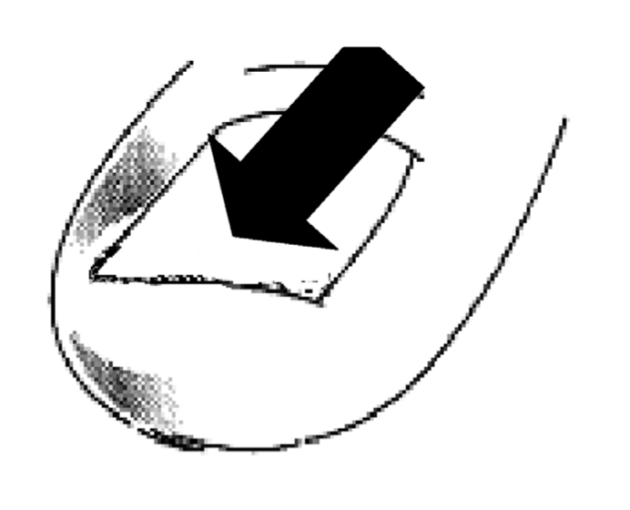Older feet naturally develop more problems because the skin tends to thin and lose its elasticity. Healing can take longer and wear and tear to the joints over the years may cause some degree of arthritic changes leading to pressure, causing the development of hard skin or corns.
But painful and uncomfortable feet aren’t a natural part of growing older or something to put up with. A lot can be done to improve comfort, relieve pain and maintain mobility.
It’s never too late to start caring
Follow the advice given in the looking after your feet leaflet and keep on the move. Keeping toenails well maintained will help keep you mobile. Do this by either cutting with nail nippers, or better still, by using a long handled foot file once a week. File in the same direction as nail growth, away from yourself.

The safest way to reach your foot is to be seated on a chair, with your foot on a towel-covered chair, opposite you. If you are able, bend your knee upwards, as this allows the foot to be closer to the body.
Keep warm, keep on the move
During the cooler months try to keep your feet as warm as possible, but don’t cook them in front of the fire! Keeping active, such as a daily walk or exercises in your chair (examples include heel to toe tapping and marching) will help keep your circulation moving. Warm stockings or socks, made from natural materials such as cotton or wool, can help. Avoid anything too tight, which can restrict your circulation, cause swelling, or cramp your toes. Wearing fleece lined boots, shoes or an extra pair of socks will also keep you warm, but make sure your shoes aren’t too tight as a result. Bed socks are also a good idea. Wearing several layers such as a thermal vest, long johns, shirt, jumper, trousers, leg warmers, hat, scarf, coat and boots, will help to reduce heat loss when out and about.
Choosing the best footwear
The older you become, the more you need a shoe that holds your foot firmly in place to give adequate support. Throw out those sloppy old favourites as they may make you unstable when you walk.
See your shoes and you leaflet for advice on footwear. This includes wearing shoes with uppers made of soft leather or stretchy man-made fabric, which is also breathable. Avoid plastic easy clean uppers which don’t allow the foot to breathe and won’t stretch to accommodate your own foot shape.
Many shoes have cushioning or shock absorbing soles to give you extra comfort while walking. When buying shoes, ensure that you can put them on and take them off easily. Check that your heel is held firmly in place, you’ll find that a lace-up or Velcro fastening shoe will give more support and comfort and is less likely to cause callus and corn formation than a slip-on.
Your shoes should be roomy enough, particularly if you intend to wear them every day. If you have swollen feet, it’s a good idea to put your shoes on as soon as you wake up, before your feet have had a chance to swell. The best time to go shopping for shoes is in the afternoon. This will ensure the shoe will fit the foot throughout the whole day. Beware of sloppy slippers, loose rugs or trailing wires, as they can increase the risk of falls. If slippers must be worn, then a Velcro fastener is recommended.
Skin care
Your skin is a natural barrier against infection and therefore it is very important to keep it as healthy as possible. If you have dry skin, a daily application of moisturiser will help to prevent the development of cracking and irritation, but do not apply between the toes.
It is also important to ensure the area between the toes is washed regularly and dried carefully, otherwise dead skin debris can build up, which tends to harbour bacteria, fungi and excessive moisture. This can reduce the skin strength, leading to moist cracks and possible development of infection.
If you have a difficulty reaching your feet, Cosyfeet:
- Phone: 01458 4472275
RDaSH Occupational Therapy Department:
- Phone: 03000 218 996
Local mobility shops sell long handled toe or foot cleaners, shoe horns, helping hand sticks to help.
Don't
- do not use sharp instruments such as razor blades to cut corns or hard skin
- do not use corn paints or corn plasters which contain acid
- do not use ingrowing toenail paints as these contain acid
Further information
If there are any changes to your health which alter your ability to maintain your own foot care, or if you develop any foot problems you cannot manage yourself, (or with the help of a carer or friend) contact your GP practice for foot care assessment.
Contact podiatry foot protection
Document control
- Document reference: DP4857/07.17.
- Date reviewed: June 2024.
Page last reviewed: October 17, 2024
Next review due: October 17, 2025
Problem with this page?
Please tell us about any problems you have found with this web page.
Report a problem